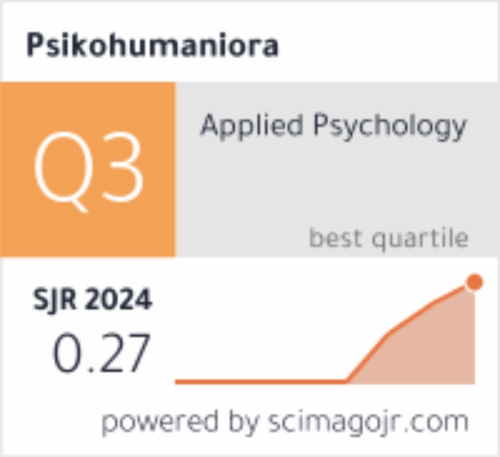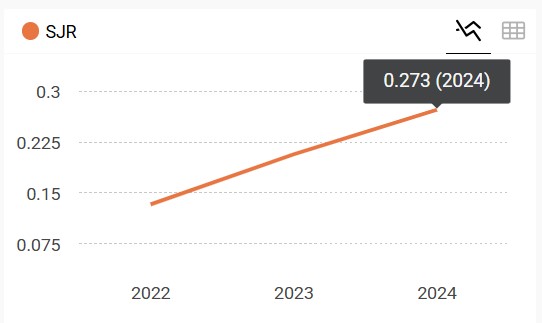Parental expressed emotions and depression among adolescents: The mediating role of emotion regulation
DOI:
https://doi.org/10.21580/pjpp.v7i2.12556Keywords:
adolescent, depression, emotion regulation, parental expressed emotionAbstract
Adolescence is a phase in life that is prone to depression. Depression in adolescents can be influenced by their family context, which can involve high parental expressed emotions and low emotion regulation among adolescents. This study aims to reveal the relationship between parental expressed emotion and adolescents’ depression, as mediated by emotional regulation in adolescents. The measuring instruments used are depression scales, the scale of adolescent emotional regulation and the scale of perceived parental expressed emotion. The participants were 212 adolescents who were identified using the purposive sampling technique. Analysis of the research data was made using simple mediation models with PROCESS. The results show a relationship between maternal expressed emotion and depression in adolescents, fully mediated by adolescent emotional regulation (BootLLCI = .030, BootULCI = .083, B = .055). There is also a relationship between fathers’ expressed emotion and depression in adolescents, partially mediated by adolescent emotional regulation (BootLLCI = .027, BootULCI = .073, B = .048). The results of the study could provide an alternative explanation of the dynamics of the relationships between fathers, mothers and adolescents. In addition, the findings emphasize the importance of adolescent emotion regulation.
Downloads
References
Beck, A. T., & Alford, B. A. (2014). Depression: Causes and treatment. University of Pennsylvania Press.
Blackwell, T. L., & McDermott, A. N. (2014). Test review: Patient Health Questionnaire–9 (PHQ-9) [Review of the test Patient Health Questionnaire–9 (PHQ-9), by R. L. Spitzer, J. B. W. Williams & K. Kroenke]. Rehabilitation Counseling Bulletin, 57(4), 246–248. https://doi.org/10.1177/0034355213515305
Branje, S. J. T., Hale, W. W., Frijns, T., & Meeus, W. H. J. (2010). Longitudinal associations between perceived parent-child relationship quality and depressive symptoms in adolescence. Journal of Abnormal Child Psychology, 38(6), 751–763. https://doi.org/10.1007/s10802-010-9401-6
Brody, L. R. (2010). Gender and emotion: Beyond stereotypes. Journal of Social Issues, 53(2), 369–393. https://doi.org/10.1111/j.1540-4560.1997.tb02448.x
Cassano, M. C., Zeman, J. L., & Sanders, W. M. (2014). Responses to children’s sadness: Mothers’ and fathers’ unique contributions and perceptions. Merrill‐Palmer Quarterly (1982-), 59(2), 1–23.
Cook, W. L., Strachan, A. M., Goldstein, M. J., & Miklowitz, D. J. (1989). Expressed emotion and reciprocal affective relationships in families of disturbed adolescents. Family Process, 28(3), 337–348. https://doi.org/10.1111/j.1545-5300.1989.00337.x
Eisenberg, N., Fabes, R. A., Guthrie, I. K., & Reiser, M. (2000). Dispositional emotionality and regulation: Their role in predicting quality of social functioning. Journal of Personality and Social Psychology, 78(1), 136–157. https://doi.org/10.1037/0022-3514.78.1.136
Eisenberg, N., Gershoff, E. T., Fabes, R. A., Shepard, S. A., Cumberland, A. J., Losoya, S. H., Guthrie, I. K., & Murphy, B. C. (2001). Mother’s emotional expressivity and children’s behavior problems and social competence: Mediation through children’s regulation. Developmental Psychology, 37(4), 475–490. https://doi.org/10.1037/0012-1649.37.4.475
Fauziyyah, A., & Ampuni, S. (2018). Depression tendencies, social skills, and loneliness among college students in Yogyakarta. Jurnal Psikologi, 45(2), 98–106. https://doi.org/10.22146/jpsi.36324
Folkman, S., & Lazarus, R. S. (1988). Coping as a mediator of emotion. Journal of Personality and Social Psychology, 54(3), 466–475. https://doi.org/10.1037/0022-3514.54.3.466
Garside, R. B., & Klimes-Dougan, B. (2002). Socialization of discrete negative emotions: Gender differences and links with psychological distress. Sex Roles, 47(3), 115–128. https://doi.org/10.1023/A:1021090904785
Gauvain, M., & Perez, S. M. (2007). The socialization of cognition. In Handbook of Socialization. The Guilford Press.
Geertz, H. (1985). Keluarga Jawa. Grafiti Press.
Gerlsma, C., & Hale, W. W. (1997). Predictive power and construct validity of the Level of Expressed Emotion (LEE) scale. British Journal of Psychiatry, 170(6), 520–525. https://doi.org/10.1192/bjp.170.6.520
Goodyer, I. M. (2001). Life events: their nature and effects. In The depressed child and adolescent (pp. 204–232). Cambridge University Press. https://doi.org/10.1017/CBO9780511543821.009
Gottman, J. M., & Levenson, R. W. (1986). Assessing the role of emotion in marriage. Behavioral Assessment, 8, 31–38.
Gross, J. J. (1998). The emerging field of emotion regulation: An integrative review. Review of General Psychology, 2(3), 271–299. https://doi.org/10.1037/1089-2680.2.3.271
Guerry, J. D., & Prinstein, M. J. (2009). Longitudinal prediction of adolescent nonsuicidal self-injury: Examination of a cognitive vulnerability-stress model. Journal of Clinical Child & Adolescent Psychology, 39(1), 77–89. https://doi.org/10.1080/15374410903401195
Hale, W. W., Raaijmakers, Q. A. W., van Hoof, A., & Meeus, W. H. J. (2011). The predictive capacity of perceived expressed emotion as a dynamic entity of adolescents from the general community. Social Psychiatry and Psychiatric Epidemiology, 46(6), 507–515. https://doi.org/10.1007/s00127-010-0218-y
Hankin, B. L., & Abela, J. R. Z. (2011). Nonsuicidal self-injury in adolescence: Prospective rates and risk factors in a 2 ½year longitudinal study. Psychiatry Research, 186(1), 65–70. https://doi.org/10.1016/j.psychres.2010.07.056
Hankin, B. L., Young, J. F., Abela, J. R. Z., Smolen, A., Jenness, J. L., Gulley, L. D., Technow, J. R., Gottlieb, A. B., Cohen, J. R., & Oppenheimer, C. W. (2015). Depression from childhood into late adolescence: Influence of gender, development, genetic susceptibility, and peer stress. Journal of Abnormal Psychology, 124(4), 803–816. https://doi.org/10.1037/abn0000089
Hayes, A. F. (2022). Introduction to mediation, moderation, and conditional process analysis: A regression-based approach (3rd ed.). The Guilford Press.
Ho, S. M. Y., Dai, D. W. T., Mak, C., & Liu, K. W. K. (2018). Cognitive factors associated with depression and anxiety in adolescents: A two-year longitudinal study. International Journal of Clinical and Health Psychology, 18(3), 227–234. https://doi.org/10.1016/j.ijchp.2018.04.001
Hom, M. A., Stanley, I. H., Rogers, M. L., Tzoneva, M., Bernert, R. A., & Joiner, T. E. (2016). The association between sleep disturbances and depression among firefighters: Emotion dysregulation as an explanatory factor. Journal of Clinical Sleep Medicine, 12(02), 235–245. https://doi.org/10.5664/jcsm.5492
Horowitz, J. L., & Garber, J. (2006). The prevention of depressive symptoms in children and adolescents: A meta-analytic review. Journal of Consulting and Clinical Psychology, 74(3), 401–415. https://doi.org/10.1037/0022-006X.74.3.401
John, O. P., & Gross, J. J. (2004). Healthy and unhealthy emotion regulation: Personality processes, individual differences, and life span development. Journal of Personality, 72(6), 1301–1334. https://doi.org/10.1111/j.1467-6494.2004.00298.x
Joormann, J., & Stanton, C. H. (2016). Examining emotion regulation in depression: A review and future directions. Behaviour Research and Therapy, 86, 35–49. https://doi.org/10.1016/j.brat.2016.07.007
Klein, D. N., Kotov, R., & Bufferd, S. J. (2011). Personality and depression: Explanatory models and review of the evidence. Annual Review of Clinical Psychology, 7(1), 269–295. https://doi.org/10.1146/annurev-clinpsy-032210-104540
Kuipers, L. (1987). Research in expressed emotion. Social Psychiatry, 22(4), 216–220. https://doi.org/10.1007/BF00583557
Kullberg, M.-L., Maciejewski, D., van Schie, C. C., Penninx, B. W. J. H., & Elzinga, B. M. (2020). Parental bonding: Psychometric properties and association with lifetime depression and anxiety disorders. Psychological Assessment, 32(8), 780–795. https://doi.org/10.1037/pas0000864
Larson, R., & Ham, M. (1993). Stress and “storm and stress” in early adolescence: The relationship of negative events with dysphoric affect. Developmental Psychology, 29(1), 130–140. https://doi.org/10.1037/0012-1649.29.1.130
Lasgaard, M., Goossens, L., & Elklit, A. (2011). Loneliness, depressive symptomatology, and suicide ideation in adolescence: Cross sectional and longitudinal analyses. Journal of Abnormal Child Psychology, 39(1), 137–150. https://doi.org/10.1007/s10802-010-9442-x
Laursen, B., Coy, K. C., & Collins, W. A. (1998). Reconsidering changes in parent-child conflict across adolescence: A meta-analysis. Child Development, 69(3), 817–832. https://doi.org/10.1111/j.1467-8624.1998.00817.x
Lefley, H. P. (1992). Expressed emotion: Conceptual, clinical, and social policy issues. Psychiatric Services, 43(6), 591–598. https://doi.org/10.1176/ps.43.6.591
Marcotte, D., Fortin, L., Potvin, P., & Papillon, M. (2002). Gender differences in depressive symptoms during adolescence. Journal of Emotional and Behavioral Disorders, 10(1), 29–42. https://doi.org/10.1177/106342660201000104
McCleary, L., & Sanford, M. (2002). Parental expressed emotion in depressed adolescents: prediction of clinical course and relationship to comorbid disorders and social functioning. Journal of Child Psychology and Psychiatry, 43(5), 587–595. https://doi.org/10.1111/1469-7610.00048
McKee, L. G., Duprey, E. B., & O’Neal, C. W. (2021). Emotion socialization and young adult internalizing symptoms: The roles of mindfulness and emotion regulation. Mindfulness, 12(1), 53–60. https://doi.org/10.1007/s12671-018-1079-9
Monnin, J., Thiemard, E., Vandel, P., Nicolier, M., Tio, G., Courtet, P., Bellivier, F., Sechter, D., & Haffen, E. (2012). Sociodemographic and psychopathological risk factors in repeated suicide attempts: Gender differences in a prospective study. Journal of Affective Disorders, 136(1–2), 35–43. https://doi.org/10.1016/j.jad.2011.09.001
Morris, A. S., Silk, J. S., Steinberg, L., Myers, S. S., & Robinson, L. R. (2007). The role of the family context in the development of emotion regulation. Social Development, 16(2), 361–388. https://doi.org/10.1111/j.1467-9507.2007.00389.x
Peltzer, K., & Pengpid, S. (2018). High prevalence of depressive symptoms in a national sample of adults in Indonesia: Childhood adversity, sociodemographic factors and health risk behaviour. Asian Journal of Psychiatry, 33, 52–59. https://doi.org/10.1016/j.ajp.2018.03.017
Peris, T. S., & Miklowitz, D. J. (2015). Parental expressed emotion and youth psychopathology: New directions for an old construct. Child Psychiatry & Human Development, 46(6), 863–873. https://doi.org/10.1007/s10578-014-0526-7
Potthoff, S., Garnefski, N., Miklósi, M., Ubbiali, A., Domínguez-Sánchez, F. J., Martins, E. C., Witthöft, M., & Kraaij, V. (2016). Cognitive emotion regulation and psychopathology across cultures: A comparison between six European countries. Personality and Individual Differences, 98, 218–224. https://doi.org/10.1016/j.paid.2016.04.022
Santrock, J. (2014). Adolescence (15th ed.). McGraw Hill.
Santrock, J. (2017). Life-span development. McGraw-Hill.
Shulman, S., & Seiffge-Krenke, I. (2015). Fathers and adolescents: Developmental and clinical perspective (1st ed.). Routledge. https://doi.org/10.4324/9781315667041
Spitzer, R. L., Kroenke, K., & Williams, J. B. (1999). Validation and utility of a self-report version of PRIME-MD: the PHQ primary care study. Primary Care Evaluation of Mental Disorders. Patient Health Questionnaire. JAMA, 282(18), 1737–1744. https://doi.org/10.1001/jama.282.18.1737
Steinberg, L. (1990). Autonomy, conflict, and harmony in the family relationship. In At the threshold: The developing adolescent (pp. 255–276). Harvard University Press.
Subandi, M. A. (2011). Family expressed emotion in a Javanese cultural context. Culture, Medicine, and Psychiatry, 35(3), 331–346. https://doi.org/10.1007/s11013-011-9220-4
Vostanis, P., & Nicholls, J. (1992). Expressed emotion in parents of non-referred children aged 6 to 11 years from two school populations: a pilot study. Child: Care, Health and Development, 18(5), 249–257. https://doi.org/10.1111/j.1365-2214.1992.tb00358.x
Wedig, M. M., & Nock, Matthew, K. (2007). Parental expressed emotion and adolescent self-injury. Journal of the American Academy of Child & Adolescent Psychiatry, 46(9), 1171–1178. https://doi.org/10.1097/chi.0b013e3180ca9aaf
Wilcox, H. C., Arria, A. M., Caldeira, K. M., Vincent, K. B., Pinchevsky, G. M., & O’Grady, K. E. (2011). Longitudinal predictors of past-year non-suicidal self-injury and motives among college students. Psychological Medicine, 42(4), 717–726. https://doi.org/10.1017/S0033291711001814
Yap, M. B. H., Allen, N. B., & Sheeber, L. (2007). Using an emotion regulation framework to understand the role of temperament and family processes in risk for adolescent depressive disorders. Clinical Child and Family Psychology Review, 10(2), 180–196. https://doi.org/10.1007/s10567-006-0014-0
Yap, M. B. H., Schwartz, O. S., Byrne, M. L., Simmons, J. G., & Allen, N. B. (2010). Maternal positive and negative interaction behaviors and early adolescents’ depressive symptoms: Adolescent emotion regulation as a mediator. Journal of Research on Adolescence, 20(4), 1014–1043. https://doi.org/10.1111/j.1532-7795.2010.00665.x
Downloads
Published
How to Cite
Issue
Section
License
The copyright of the accepted article shall be assigned to the publisher of the journal. The intended copyright includes the right to publish the article in various forms (including reprints). The journal maintains the publishing rights to published articles.
In line with the license, authors and any users (readers and other researchers) are allowed to share and adapt the material only for non-commercial purposes. In addition, the material must be given appropriate credit, provided with a link to the license, and indicated if changes were made. If authors remix, transform, or build upon the material, authors must distribute their contributions under the same license as the original.



